Velvet Revolution embraced Gandhian ethics of responsibility, commitment to human dignity
Source: The Indian Express / www.indianexpress.com / By Ramin Jahanbegloo /
Let us not forget that the strategies of non-violent resistance, dissent and non-cooperation suggested by Havel were presented by him as different ontological modes of living within truth. They became successful in 1989 by echoing an ethical dimension of politics in all of Eastern Europe.

November 17 marked the 30th anniversary of the Velvet Revolution organised by the Czech Civic Forum and the Slovak public against one of the last Soviet-orbit regimes. The Velvet Revolution (sametová revoluce) was a non-violent transition of power in what was then Czechoslovakia. The Czech and Polish experiences of democracy have shown that democratisation in Eastern Europe took place less within the framework of the existing state systems than at the level of civil societies. When the Czech and Polish dissidents of the 1980s were struggling against their communist authoritarian regimes, they returned to the concept of civil society. What Eastern European intellectuals and civic actors understood by civil society was not just the 18th century concept of the rule of law, but also the notion of horizontal self-organised groups and institutions in the public sphere that could limit the power of the state by constructing a democratic space separate from state and its ideological institutions.
Before 1989 and the rise of liberal values in Eastern Europe, many observers argued about the weakness of the civil societies in the region. This perspective forgot two things. First, the sheer ruthlessness of communist regimes that refused civic dissent any room to manoeuvre: No free trade unions, no real opposition, no free press, no tolerance of even a hint of dissidence. Second, the miracle that stubborn civil societies did persist in countries like Poland and Czechoslovakia — even after decades of Stalinist rule, students, intellectuals and artists continued their work and helped to lay the ground for the democratic revolt.
Moreover, the Czech experience showed us that even within a totalitarian society, a basis for “civic pluralism” can be created. Although other forms of civility existed in East European societies, this civic pluralism — with roots in a philosophical reading of pluralism, in opposition to ideological “monism” — offered a rich model for those dissidents seeking to make democratic change sustainable. Not surprisingly, dissidents like Adam Michnik in Poland and Vaclav Havel in Czechoslovakia opened spaces for new civil and democratic politics in Eastern Europe. Charter 77, the Czechoslovak manifesto for human rights, issued in January 1977 by Havel, Jan Patocka and Jiri Hájek, paved the way to the events of the “Velvet Revolution” of November 17, 1989. Havel’s political philosophy was marked by notions such as “truth”, “conscience”, “responsibility” and “civility”. His emphasis on the acknowledgment of truth as an essential value arose from his concern with what he called “living in truth” in a post-totalitarian state. Havel insisted in his writings that, “Individuals. need not accept the lie. It is enough for them to have accepted their life with it and in it.” So, the problem for Havel was to confront political power by inviting people to live in truth and justice, and for decency.
As such, Havel showed brilliantly how the system successfully captures the lived experience of individuals in a post-totalitarian state by giving them the illusion of being part of a silent contract. That is why, for Havel, not becoming a player in the game of a post-totalitarian state was an embryonic act of dissent. What was important was defending one’s dignity and regaining one’s sense of responsibility. This was clearly a moral act, which was defined by Havel as “living within truth”. Havel analysed the essence of living within truth while examining the various dimensions of what he called “the power of the powerless”. He affirmed: “When I speak of living within truth, I naturally do not have in mind only products of conceptual thought, such as a protest or a letter written by a group of intellectuals. It can be any means by which a person or a group revolts against manipulation: Anything from a letter by intellectuals to a workers’ strike, from a rock concert to a student demonstration, from refusing to vote in the farcical elections, to making an open speech at some official congress, or even a hunger strike.”

